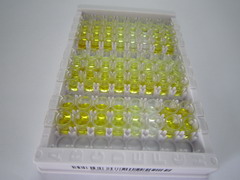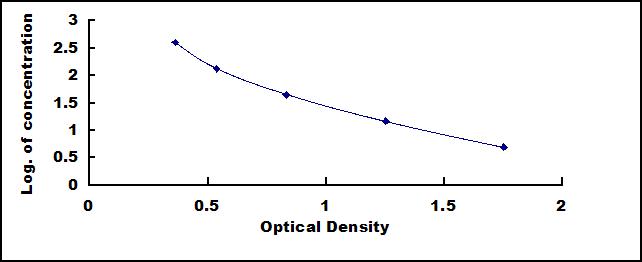Packages (Simulation)

Reagent Preparation

Image (I)
Image (II)
Certificate


ELISA Kit for Hyaluronic Acid (HA)
Hyaluronan; Hyaluronate
- Product No.CEA182Ge
- Organism SpeciesPan-species (General) Same name, Different species.
- Sample Typeserum, plasma and other biological fluids
- Test MethodCompetitive Inhibition
- Assay Length2h
- Detection Range4.94-400ng/mL
- SensitivityThe minimum detectable dose of this kit is typically less than 1.77ng/mL.
- DownloadInstruction Manual
- UOM 48T96T 96T*5 96T*10 96T*100
- FOB
US$ 557
US$ 796
US$ 3580
US$ 6763
US$ 55692
For more details, please contact local distributors!
Specificity
This assay has high sensitivity and excellent specificity for detection of Hyaluronic Acid (HA).
No significant cross-reactivity or interference between Hyaluronic Acid (HA) and analogues was observed.
Recovery
Matrices listed below were spiked with certain level of Hyaluronic Acid (HA) and the recovery rates were calculated by comparing the measured value to the expected amount of Hyaluronic Acid (HA) in samples.
| Matrix | Recovery range (%) | Average(%) |
| serum(n=5) | 96-105 | 101 |
| EDTA plasma(n=5) | 80-93 | 85 |
| heparin plasma(n=5) | 92-101 | 96 |
Precision
Intra-assay Precision (Precision within an assay): 3 samples with low, middle and high level Hyaluronic Acid (HA) were tested 20 times on one plate, respectively.
Inter-assay Precision (Precision between assays): 3 samples with low, middle and high level Hyaluronic Acid (HA) were tested on 3 different plates, 8 replicates in each plate.
CV(%) = SD/meanX100
Intra-Assay: CV<10%
Inter-Assay: CV<12%
Linearity
The linearity of the kit was assayed by testing samples spiked with appropriate concentration of Hyaluronic Acid (HA) and their serial dilutions. The results were demonstrated by the percentage of calculated concentration to the expected.
| Sample | 1:2 | 1:4 | 1:8 | 1:16 |
| serum(n=5) | 86-101% | 95-104% | 79-88% | 84-98% |
| EDTA plasma(n=5) | 79-97% | 78-104% | 87-105% | 89-103% |
| heparin plasma(n=5) | 96-105% | 89-97% | 94-105% | 97-104% |
Stability
The stability of kit is determined by the loss rate of activity. The loss rate of this kit is less than 5% within the expiration date under appropriate storage condition.
To minimize extra influence on the performance, operation procedures and lab conditions, especially room temperature, air humidity, incubator temperature should be strictly controlled. It is also strongly suggested that the whole assay is performed by the same operator from the beginning to the end.
Reagents and materials provided
| Reagents | Quantity | Reagents | Quantity |
| Pre-coated, ready to use 96-well strip plate | 1 | Plate sealer for 96 wells | 4 |
| Standard | 2 | Standard Diluent | 1×20mL |
| Detection Reagent A | 1×120µL | Assay Diluent A | 1×12mL |
| Detection Reagent B | 1×120µL | Assay Diluent B | 1×12mL |
| TMB Substrate | 1×9mL | Stop Solution | 1×6mL |
| Wash Buffer (30 × concentrate) | 1×20mL | Instruction manual | 1 |
Assay procedure summary
1. Prepare all reagents, samples and standards;
2. Add 50µL standard or sample to each well.
And then add 50µL prepared Detection Reagent A immediately.
Shake and mix. Incubate 1 hour at 37°C;
3. Aspirate and wash 3 times;
4. Add 100µL prepared Detection Reagent B. Incubate 30 minutes at 37°C;
5. Aspirate and wash 5 times;
6. Add 90µL Substrate Solution. Incubate 10-20 minutes at 37°C;
7. Add 50µL Stop Solution. Read at 450 nm immediately.
GIVEAWAYS
INCREMENT SERVICES
| Magazine | Citations |
| Clinical Infectious Diseases | Hemorrhagic Fever Caused by a Novel Bunyavirus in China: Pathogenesis and Correlates of Fatal Outcome OxfordJournals: source |
| Critical Care Medicine | Alveolar fluid in acute respiratory distress syndrome promotes fibroblast migration: Role of platelet-derived growth factor pathway* PubMed: 22713216 |
| European Archives of Oto-Rhino-Laryngology | Age effects on extracellular matrix production of vocal fold scar fibroblasts in rats Pubmed: 24077847 |
| Journal of Voice | Vocal Fold Fibroblast Response to Growth Factor Treatment is Age Dependent: Results From an In Vitro Study ScienceDirect: S0892199713002415 |
| Gynecol Oncol. | Resveratrol inhibits ovarian cancer cell adhesion to peritoneal mesothelium in vitro by modulating the production of α5β1 integrins and hyaluronic acid Pubmed:24995580 |
| Laryngoscope. | Establishing principles of macromolecular crowding for in vitro fibrosis research of the vocal fold lamina propria Pubmed:25545625 |
| Life Sci | Pituitary tumor transforming gene as a novel regulatory factor of liver fibrosis PubMed: 25936962 |
| Nutr Cancer | Camel Milk: Potential Utility as an Adjunctive Therapy to Peg-IFN/RBV in HCV-5 Infected Patients in Egypt PubMed: 26492131 |
| Journal of Clinical Gastroenterology and Hepatology | Study of Some Serum Biochemical Markers of Liver Fibrosis in Patients with Chronic HCV ISSN 2575-7733 |
| BMC Complementary and Alternative Medicine | A putative Chondroprotective role for IL-1β and MPO in herbal treatment of experimental osteoarthritis pubmed:29166937 |
| Experimental and Therapeutic Medicine | Polycomb group proteins: Novel molecules associated with ultraviolet A-induced photoaging of human skin. pubmed:28962194 |
| European Journal of Applied Physiology | The effect of aerobic walking and lower body resistance exercise on serum COMP and hyaluronan, in both males and females Pubmed:29536174 |
| European Food Research and Technology | Evaluation of antifibrotic effects of coffee and cocoa extracts in rats with thioacetamide-induced fibrosis 10.1007:s00217-018-3119-z |
| BioMed Research International | Juvenile Ovine Ex Vivo Larynges: Phonatory, Histologic, and Micro CT Based Anatomic Analyses |
| Advances in Medical Sciences | Selected elements of extracellular matrix of the skin in diabetes and insulin resistance Pubmed: 31146169 |
| Viruses | Strain-Dependent Porcine Circovirus Type 2 (PCV2) Entry and Replication in T-Lymphoblasts Pubmed: 31480752 |
| Physiology International | Betulin attenuated liver damage by prevention of hepatic mitochondrial dysfunction in rats with alcoholic steatohepatitis Pubmed: 31619044 |
| Journal of Clinical Medicine | Damage-Associated Molecular Patterns and Th-Cell-Related Cytokines Released after Progressive Effort Pubmed: 32210109 |
| Journal of Proteomics | iTRAQ-based analysis for the identification of MARCH8 targets in human esophageal squamous cell carcinoma 33540066 |
| Eur J Appl Physiol | An exploratory study to investigate the association between age, physical activity, femoral trochlear cartilage thickness and biomarkers of tissue metabolism in?¡ 33713200 |
| J Cell Physiol | Trimethylamine N‐oxide exacerbates acetaminophen‐induced liver injury by interfering with macrophage‐mediated liver regeneration 34459512 |
| Experimental Cell Research | Comparative studies on the effect of pig adipose-derived stem cells (pASCs) preconditioned with hypoxia or normoxia on skin wound healing in mice Pubmed:35718003 |
| Biomedicine & Pharmacotherapy | Bicyclol ameliorates advanced liver diseases in murine models via inhibiting the IL-6/STAT3 signaling pathway Pubmed:35658240 |
| Sensors and Actuators B: Chemical | Novel multifunctional delivery system for chondrocytes and articular cartilage based on carbon quantum dots |
| Catalog No. | Related products for research use of Pan-species (General) Organism species | Applications (RESEARCH USE ONLY!) |
| CPA182Ge11 | BSA Conjugated Hyaluronic Acid (HA) | Immunogen; SDS-PAGE; WB. |
| CPA182Ge21 | OVA Conjugated Hyaluronic Acid (HA) | Immunogen; SDS-PAGE; WB. |
| PAA182Ge01 | Polyclonal Antibody to Hyaluronic Acid (HA) | ELISA, CLIA. / IHC-Fr, ICC, IP (predicted). |
| PAA182Ge02 | Polyclonal Antibody to Hyaluronic Acid (HA) | ELISA, CLIA. / IHC-Fr, ICC, IP (predicted). |
| LAA182Ge81 | FITC-Linked Polyclonal Antibody to Hyaluronic Acid (HA) | WB; IHC; ICC; IF. |
| LAA182Ge71 | Biotin-Linked Polyclonal Antibody to Hyaluronic Acid (HA) | WB; IHC; ICC. |
| MAA182Ge22 | Monoclonal Antibody to Hyaluronic Acid (HA) | ELISA, CLIA. / IHC-Fr, ICC, IP (predicted). |
| MAA182Ge21 | Monoclonal Antibody to Hyaluronic Acid (HA) | ELISA, CLIA. / IHC-Fr, ICC, IP (predicted). |
| MEA182Ge | Mini Samples ELISA Kit for Hyaluronic Acid (HA) | Enzyme-linked immunosorbent assay for Antigen Detection. |
| CEA182Ge | ELISA Kit for Hyaluronic Acid (HA) | Enzyme-linked immunosorbent assay for Antigen Detection. |
| LMA182Ge | Multiplex Assay Kit for Hyaluronic Acid (HA) ,etc. by FLIA (Flow Luminescence Immunoassay) | FLIA Kit for Antigen Detection. |
| KSA182Ge11 | ELISA Kit DIY Materials for Hyaluronic Acid (HA) | Main materials for "Do It (ELISA Kit) Yourself". |









